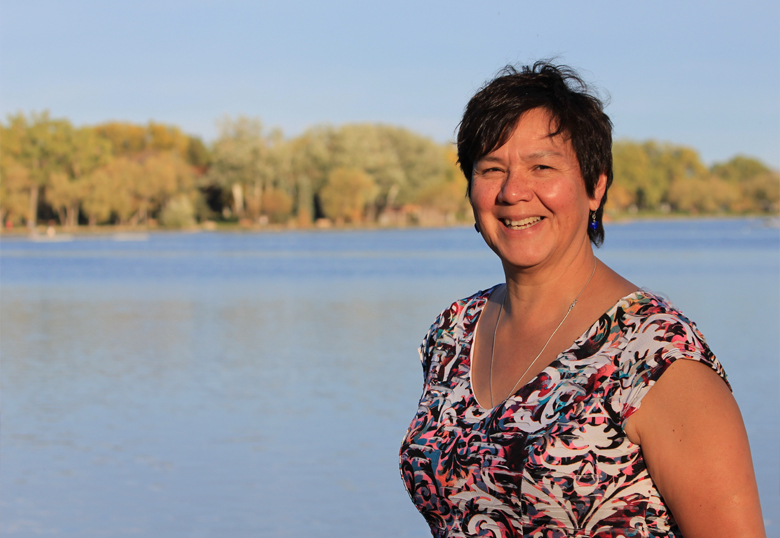In the summer of 2014, Dr. Esther Tailfeathers drove into the parking lot of a store in south Lethbridge. As she pulled into a parking spot, she noticed something amiss in the next car. One of the doors swung open and a young man fell out onto the pavement.
Tailfeathers, a physician, rushed to help. The young man wasn’t breathing so she began administering CPR and, by the time the ambulance arrived, the young man had a pulse and was breathing again. Children inside the young man’s vehicle were crying and when Tailfeathers asked them what had happened, they said the young man had taken some kind of medication.
That was Tailfeathers’ first case of fentanyl overdose and, although she didn’t know it at the time, she’d encounter many more in her work in Standoff and Cardston.
In the intervening months, Tailfeathers played an integral role in mobilizing a community response. For her efforts, the Faculty of Health Sciences has chosen her as a recipient of the Friends of Health Sciences Award. The annual award recognizes those who exemplify outstanding support of the mission and goals of the faculty.

“That was quite a surprise and a huge honour,” says Tailfeathers, quickly adding that many other people were involved. “It’s not just me who made an effort. There were a lot of people who worked hard at making a difference on the reserve.”
Tailfeathers was born and raised on the Blood Reserve. In addition to working in a clinic in Stand Off, she is an associate at a medical clinic in Cardston, sharing on-call and emergency duties with her colleagues. She also provides physician services in Fort Chipewyan one week a month.
As a physician, Tailfeathers had treated overdoses, typically for prescription narcotics or street drugs like crack cocaine. When the number of people overdosing started to climb, she and her colleagues screened for drugs and found fentanyl, a drug 100 times more toxic than morphine, heroin or oxycodone, was responsible. They now knew what they were dealing with but the number of overdoses continued to rise.
“One of my colleagues saw two in a day and then we started seeing three to four overdoses a day that were quickly resolved with the antidote, Narcan,” says Tailfeathers. “Then we started seeing deaths in the community, mostly young people in their twenties.
“By October of last year we had all become very alarmed as physicians. I had contacted the police several times about the drugs that were coming through and had the police watch out for dealers in the community. My patients were telling me what was happening. Many mothers and sisters or children of these patients were telling me my patients were taking Oxy 80s. Actually, it was fentanyl and they were snorting it.”
By November, the crisis reached a height. Tailfeathers notified chief and council and a group came together to develop a community response. They began educating community members about the dangers of fentanyl and several rallies were organized.
Tailfeathers worked with Health Canada to bring Narcan kits to the community and into the hands of family members who were afraid their loved one was in danger of overdosing. In partnership with Lethbridge HIV Connection, the community group began educating people in how to use the kits.
“We had no idea so many people were using fentanyl and it’s so highly addictive that after the first or second use they were hooked,” she says. “We began to see people selling everything they had to get it.”
The community began to see an increase in crime, especially break-ins and theft. At first, thieves stole mainly televisions and other electronic devices but when those were gone, thieves took to stealing food. Violence also escalated when police started to crack down on the dealers.
“As a result, we’re seeing the family breakdowns, increased crime and increased poverty and hunger because people are using their money to buy the drugs and the children are not getting the food that they need,” says Tailfeathers. “It drains the resources from people who are already poverty stricken.”
In addition to providing Narcan kits, counsellors working in the addictions field are learning skills to deal with fentanyl addiction and more spaces for detox and treatment were made available throughout the province. In-hospital detox was started but unfortunately, many people leave treatment too early.
“The problem is that the drug is so addictive. It really needs special attention,” she says.
Treatment with suboxone is being offered through the medical clinic in Levern, a community on the Blood Reserve. Suboxone treatment is similar to methadone treatment for heroin addiction. Planning for an addictions treatment clinic is also underway.
Tailfeathers says the community is tackling a huge problem. People have experienced trauma as a result of almost 20 deaths due to fentanyl overdoses. Resources that were thin to begin with have been stretched even further. To get at the root of the problem, work must also tackle the health determinants, such as poverty, lack of housing and lack of employment.
“I don’t think our community was targeted. It was just a very naïve community to fentanyl. People had no idea about the destructive power of that drug,” says Tailfeathers. “The silver lining in the cloud is seeing people come forward and being really alive and energetic about helping the community. I think that was the key to slowing this crisis down.”
The measures introduced in response to the crisis have made a big difference and the number of deaths due to fentanyl overdose has declined to around one a month.
“It’s built some confidence back in us that we can do this, we don’t have to wait for somebody in the outside community to come in and save us. We’re doing it ourselves and that’s so important, regaining the confidence within our community to be able to deal with a crisis,” says Tailfeathers.
